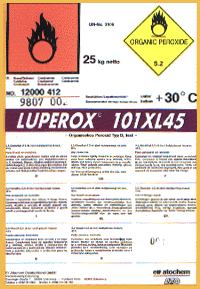


|
Organic peroxides are characterised by an oxygen-oxygen bond in their molecular structure. Certain conditions involve
the cleavage of this bond, creating very reactive radicals.
Due to this high reactive, organic peroxides require special care and attention, when being handled and stored.
Therefore, organic peroxides must be handled only by personnel well informed on safety conditions who should
always refer to the safety data sheet before handling the product.
Physical and chemical hazards Main causes of peroxide decomposition are heat, fire and chemical contamination. According to European regulations, our peroxides have been tested to assess the hazards relate to flame-mability, sensitivity to shoke and heat. Flammability Organic peroxides are highly flammable, contact with combustible material may cause fire. Thermal decomposition creates flammable and harmful products. - All source of sparks and ignition must be prohibited; smoking must be forbidden. - Fire must be extinguished with water spray and form. Specific methods to put out the fire are given in the safety data sheet. Among the dialkyl peroxides, LUPEROX DI (Di-tert-butylperox), due to its very low flash point, must be handleed as aflammable liquid. Heat sensitivity Organic peroxides are sensitive to heat and above a certain temperature, their decomposition becomes uncontrolled. The self accelerating decomposition of temperature (SADT) provides a measure of this hazard and is used to determine the maximum allowable storage and transport temperature. - Storage temperature mustbecontrolled. Contamination Chemical contamination can accelerate decomposition of organic peroxides. - Avoid contact with oxidizing and reducing agents, metal salts, acids and bases. - Never return unused product to orginal container. Health risk and personnel protection Some of the dialky peroxides are skin and eyes irritants and nessary handling precautions should be observed, i.e : - specific protection must be used whenhandling these product : wear gloves, safety glasses or gogles, protective clothing ; - avoid contact with skin and eyes ; avoid inhalation of vapours |

|
Safe storage Proper storage is critical to the safe handling of organic peroxides. Storage is subjected to national and local regulations concerning such activities in terms of safety and protection of the enviorment. These regulations must be carefully checked before storing organic peroxides. Storage facilities All peroxide storage facilities should be designed along the following basic guidelines. They should be located in an isolated area; they should be explosion-proof, and free of all combustible material Storage Temperature The best way to avoid decomposion due to heat is to strictly respect the recommended storage temperature. Keep at temperatures below 30℃ Peroxides must be stored in their original packages. Transport and packaging Transport Transport of organic peroxides is governed by national and international regulations. Organic Peroxides are classified according to the degree of hazard they present ; they belong to the specific class 5.2. the control temperature and emergency temperature are derived from the SADT. Due to their high SADT, dialkyl peroxides do not require refrigerated transport. However, to maintain the the quality of the peroxides, the maximum transport temperature has to be kept below 30℃  Packaging Packaging methods and maximum capacity allowed in packaging are also described in the tansport regulations, depending on the peroxide characteristics. Regulatory information relate to handling and transport is given on the package labels. A model of label is given below. |
LUPEROX | Chemical structures | Chemical and physical data | LUPEROX range | Storage-handling-safety
부산광역시 사하구 하단동 240-13 청구빌딩 5층(604-020) / 전화 : 051-208-5188 / 팩스 : 051-204-4338